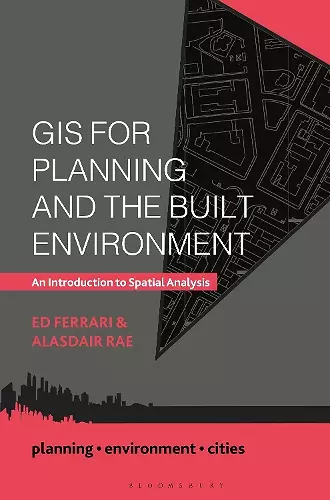GIS for Planning and the Built Environment
An Introduction to Spatial Analysis
Alasdair Rae author Ed Ferrari author
Format:Paperback
Publisher:Bloomsbury Publishing PLC
Published:27th May '19
Should be back in stock very soon

This much-needed new core textbook introduces readers to the world of geographic information systems and spatial analysis. In addition to explaining what GIS is, the authors cover such topics as geovisualization, mapping principles, spatial analysis, network analysis, and decision making.
This engaging and practical guide is a much-needed new textbook that illustrates the power of geographic information systems (GIS) and spatial analysis. Today’s planner has a wealth of data available to them, much of which is increasingly linked to a specific location. From football clubs to Twitter conversations, government spending to the spread of diseases – data can be mapped. Once mapped, the data begins to tell stories, patterns are revealed, and effective planning decisions can be made. When used effectively, GIS allows students, planners, residents and policymakers to solve wicked problems in the environment, society and the economy.
Geospatial data is now more freely available than it ever has been, as is much of the necessary software to analyse it. This contemporary text offers a practical guide to spatial analysis and what it can show us. In addition to explaining what GIS is and why it is such a powerful tool, the authors cover such topics as geovisualization, mapping principles, network analysis and decision making. Offering more than just theoretical or technical principles and concepts, the book applies GIS techniques to the real world, draws on global examples and provides practical advice on mapping the built environment.
This accessible text is essential reading for undergraduate and postgraduate students taking planning modules on GIS, data analysis and mapping, as well as for all planners, urbanists and geographers with an interest in how GIS can help us better understand the built environment from a socio-economic perspective.
GIS for Planning and the Built Environment is a really interesting book with a unique and refreshing approach to GIS. This text provides an effective cross-sectional overview of GIS and spatial analysis concepts and refers to many real-world examples which should be useful to planners. The book has a universal appeal as it focuses on a wide range of GIS principles that can be implemented across various planning systems. * Les Dolega, University of Liverpool, UK *
GIS for Planning and the Built Environment is a brilliant take on the current state of Geographic Information Systems across the globe and is a must-read for planners, students and GIS technicians. Ferrari and Rae’s ability to expertly capture and describe the history and future of Geographic Information Systems seems effortless. A quick and engaging read, this book would make an excellent textbook for college-level GIS and/or Planning classes. I highly recommend it! * Tony Giarrusso, Georgia Institute of Technology, USA *
This book walks the reader through the thought processes that are needed to go from having a bit of geographical data to analysing and presenting it in a clear and effective way. The strength of this book is that provides a toolkit of approaches and applications which are independent of technology, software and location. It is also written in a user friendly style that will make it a useful text for many students, practitioners and professionals in the fields of GIS, planning and the built environment. * Ruth Hamilton, University of Sheffield, UK *
GIS for Planning and the Built Environment provides a “why to guide” to the potential of GIS, accompanied by contemporary examples and applications. It is the perfect text for students accessing GIS for the first time as it showcases the potential and recent explosion of demand for geo-visualisation, communication and accessibility of spatial data. * Damien Mansell, University of Exeter, UK *
This book expertly weaves together the applied and the academic, the conceptual and the technical. It explains in a very clear manner a range of spatial analytical techniques that can be applied to evidence-based planning in an increasingly complex and nuanced world. It will serve as an excellent text in upper-level undergraduate or graduate-level courses. * Siqing Chen, University of Melbourne, Australia *
This book represents a good first step towards learning the use of GIS methods for planners. I find it useful both for students and for professionals within the field, with its focus on applied methods and with many relevant practical examples. I'm particularly pleased that network analysis has been included here, a topic applicable for planning that I have missed in many of the generic GIS textbooks available elsewhere. * Yngve Karl Frøyen, Norwegian University of Science and Technology, Norway *
GIS and planning have both undergone substantial change in recent decades; the authors are ideally placed to traverse these developments and to provide a much needed update on the relationship between the two fields. As well as moving past more caricaturised views, they also tackle the hype surrounding GIS in order to demonstrate the latter’s relevance to contemporary urban planning processes and problems. Throughout the book the main emphasis is on the strengths and limits of GIS for managing, visualising and communicating information and for supporting decision-making. All too often GIS lecturers may be unfamiliar with the best means to approach these issues with those among their students who doing planning degrees, while vice versa their planning colleagues may struggle to maintain abreast of GIS. This book successfully fills this gap in an engaging and accessible style and with a range of well-chosen examples. * Alistair Geddes, University of Dundee, UK *
ISBN: 9781137307149
Dimensions: 234mm x 156mm x 12mm
Weight: 300g
175 pages